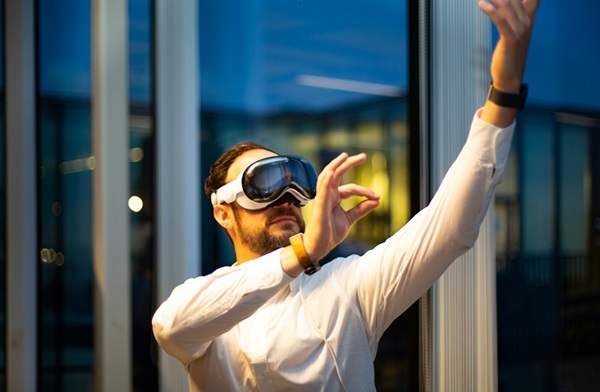In a rapidly evolving technological landscape, the world of augmented reality (AR) is captivating minds and transforming industries. AR smart glasses technology has emerged as groundbreaking devices, bringing virtual elements into the real world. This article delves into the dynamic realm of AR eyewear, pitting pioneers, tech giants, and independent innovators against each other in an electrifying showdown.

I. Introduction
What is Smart Glasses Technology?
Smart glasses technology is wearable devices that overlay digital information onto the wearer’s field of view, augmenting their perception of the world around them.
The Rise of Augmented Reality (AR)
Augmented reality, or AR, is a technology that superimposes computer-generated images, sound, or other data onto the real world. It has found applications in gaming, education, medical fields, and beyond.
The Battle in the AR Eyewear Market
The AR eyewear market has been gaining momentum over the years, with major players vying for supremacy. Let’s explore the contenders.
II. The Pioneers
Google Glass: A Trailblazer
Google Glass, the early pioneer of AR eyewear, created a buzz with its innovative design. It was a stepping stone for the AR revolution, although it initially faced privacy concerns and limited adoption.
Microsoft HoloLens: Mixed Reality Innovators
Microsoft HoloLens blended the real and virtual worlds, targeting both consumers and enterprises. Its Mixed Reality (MR) technology brought spatial computing to the forefront.
Snap Spectacles: Augmented Reality for Consumers
Snap Spectacles ventured into consumer AR, focusing on social media integration. They became synonymous with playful AR experiences and short video clips.
III. Tech Titans Enter the Ring
Apple AR Glasses: A Game-Changing Announcement
Apple’s entry into the AR arena signaled a major shift. Leveraging a mix of ARKit and ARCore, Apple aimed to deliver a seamless AR experience to its massive user base.
Facebook (Meta) Smart Glasses Technology: Socially Connected AR
Meta, formerly Facebook, introduced smart glasses technology emphasizing social connectivity. Their partnership with Ray-Ban produced stylish eyewear with integrated cameras.
Amazon’s Project Kuiper: A Surprise Contender
Amazon, not to be left behind, ventured into AR with Project Kuiper. This e-commerce giant focused on the potential of cloud-powered AR, potentially revolutionizing online shopping.
IV. Independent Innovators
Magic Leap: Raising the Bar in AR
Magic Leap’s technology introduced the world to spatial computing with its Lightfield technology. The startup attracted significant investment and aimed at improving the AR experience.
Nreal Light: Lightweight and Stylish AR Glasses
Nreal Light offered a balance between style and substance, presenting lightweight AR glasses. These appealed to consumers looking for everyday wear.
Vuzix Blade: AR for the Enterprise
Vuzix Blade targeted enterprise users, incorporating features like voice commands and an intuitive interface for industrial applications.
V. Design and Comfort
Form vs. Function: Balancing Style and Wearability
Finding the right balance between aesthetics and comfort is essential for AR glasses. Users seek a device that seamlessly fits into their daily lives.
Weight and Ergonomics
The weight and ergonomics of AR glasses play a crucial role in ensuring user comfort, especially during extended usage.
Customization Options
Personalization is key. Offering customization options allows users to tailor their AR glasses to their preferences, enhancing the overall experience.

VI. Display Technology
Optical Displays: Projecting the Virtual World
The method of projecting virtual elements onto the real world varies. Optical displays, such as Micro OLED, create a vivid AR experience.
Waveguides vs. Diffractive Waveguides
AR glasses utilize different waveguide technologies for creating virtual images. Understanding the nuances between waveguides is essential for consumers.
Field of View (FOV): Immersive Experience
A wider field of view contributes to a more immersive AR experience. Users should consider FOV when choosing their AR glasses.
VII. User Interface and Interaction
Voice Commands: The Future of Control
Voice commands offer hands-free interaction, enhancing the user’s ability to interact with their environment.
Gesture Control: Hands-Free Navigation
Gesture control provides a more intuitive means of navigation and interaction with the virtual elements.
Touch Controls: Intuitive Interaction
Touch controls add a layer of interactivity, giving users the ability to manipulate digital elements seamlessly.
VIII. Content and Applications
Gaming and Entertainment
AR glasses have revolutionized gaming and entertainment, allowing users to step into their favorite games or enjoy immersive cinematic experiences.
Work and Productivity
In the professional sphere, AR glasses have streamlined workflows, aiding in remote collaboration and offering real-time data visualization.
Social Interaction and Communication
AR glasses enable innovative ways of social interaction, bridging geographical gaps and creating shared experiences.
IX. Connectivity and Ecosystem
Wireless Connectivity: Staying Tether-Free
Seamless wireless connectivity ensures users can move freely without cumbersome cables, enhancing the AR experience.
App Stores and AR Content
A robust ecosystem of apps and AR content is crucial for users to make the most of their AR glasses.
Integration with Other Devices
Compatibility with other devices, such as smartphones and smart home appliances, extends the utility of AR glasses.
X. Battery Life and Charging
Power Efficiency in AR Glasses
Optimizing power consumption is essential to ensure that AR glasses last through a full day’s usage.
Charging Methods and Durability
The method of charging and the durability of batteries affect the overall user experience and long-term reliability.
Battery Life vs. Performance
Users often face the trade-off between battery life and device performance. Balancing these factors is a key consideration.

XI. Price Points and Accessibility
Luxury vs. Affordable AR Eyewear
AR glasses come in various price ranges, from luxury offerings to more affordable models, catering to a broad spectrum of consumers.
Potential Price Reductions
As technology advances and competition increases, the cost of AR glasses may decrease, making them more accessible.
Accessibility to the Masses
The goal is to make AR glasses accessible to as many people as possible, democratizing the technology.
XII. Privacy and Security Concerns
Data Collection and Sharing
Understanding how AR glasses handle data, including what is collected and shared, is vital for user privacy.
Camera and Recording Capabilities
AR glasses with built-in cameras raise concerns about personal privacy and the ethical use of recording capabilities.
Addressing Privacy Issues
Companies must address and resolve privacy concerns to build user trust and ensure the responsible use of AR technology.
XIII. Development and Future Prospects
Developer Communities
Vibrant developer communities contribute to the growth of AR glasses, fostering the creation of new applications and features.
Future Technological Advancements
The future holds exciting technological advancements, from improved displays to more sophisticated user interfaces.
The Evolution of AR Glasses
AR glasses are in a constant state of evolution, with each iteration promising more advanced capabilities and greater user satisfaction.
XIV. Consumer and Industry Adoption
Early Adopters
Early adopters play a crucial role in testing and popularizing AR glasses, influencing their adoption in mainstream culture.
Industries Embracing AR Technology
Various industries, including healthcare, education, and manufacturing, are integrating AR glasses into their operations.
Challenges in Widespread Adoption
Challenges such as cost, usability, and public perception need to be overcome for the widespread adoption of AR glasses.
XV. Regulatory and Ethical Considerations
AR Glasses and Road Safety
Regulations regarding the use of AR smart glasses technology while driving are vital for public safety.
Privacy Regulations and AR Data
Regulations concerning the collection and use of data from AR smart glasses technology are essential for protecting user privacy.
Ethical Use of AR Smart Glasses Technology
Ensuring the ethical use of AR smart glasses technology is a collective responsibility, safeguarding against misuse.
XVI. Competitive Landscape
Head-to-Head Comparisons
Comparing the strengths and weaknesses of different AR smart glasses technology is crucial for consumers in making informed decisions.
Market Share and Predictions
Tracking market share and predicting future trends is essential for businesses and investors in the AR eyewear market.
Collaboration and Partnerships
Collaborations between tech companies, eyewear manufacturers, and content creators are shaping the future of AR smart glasses technology.
XVII. Conclusion
The Augmented Reality eyewear landscape is a dynamic arena where innovation and competition converge to redefine our perception of reality. As consumers, it is vital to stay informed about the latest advancements and choose the AR smart glasses technology that best aligns with our needs and desires. The AR revolution continues, promising a future where the virtual and real worlds seamlessly coexist.

